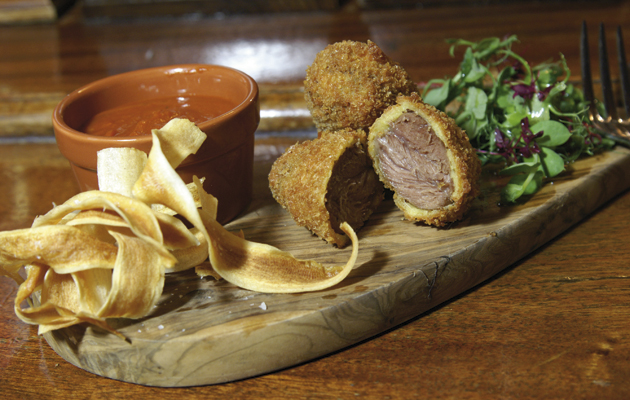Pig's cheeks are the tastiest mouthful. Buy British pork and try them confit and in breadcrumbs.
Pig’s cheeks are a delicious part of the pig. They have been growing in popularity over the last few years, and now pig’s cheeks are not just found in restaurants, but on the dinner table too.
The most important thing to remember before you start cooking your pig’s cheeks is to get your pork from a reputable source. Buy British, without question. Our pigs have a better standard of living than their Continental cousins. If you can choose organic, or even better buy from a local farmer you know. When it comes to pork the more you know and the better. Tracey Worcester is passionate about pigs, and we would encourage you to sign her Pig Pledge to encourage farms not factories. For her manifesto read her Tracey Worcester: If I ruled the world column.
Pig’s cheeks are meaty lumps that need some cooking. On the principle that the muscle that does the most work tastes the best, the cheeks on any animal should be supreme, and indeed they are. They just take some cooking.
PIG’S CHEEKS RECIPE
Serves 6
12 pig’s cheeks, trimmed and neat
100g (31⁄2oz) sea-salt
Sprig rosemary, stripped
2 litres (31⁄2 pints) goose or duck fat (you can reuse this numerous times)
2 eggs
100ml (31⁄2fl oz) milk
2 tbsp flour
200g (7oz) dried breadcrumbs (evenly sized)
3 litres (5 pints) vegetable oil
These sound exotic but are really easy to do. You will have to ask your butcher for them but if you order enough ( at least 5 kilos) he will get them. Freeze what you can’t use for next time. They are really cheap and taste divine. We are going to cook them confit-style – slowly braised at a low temperature in goose or duck fat.
Sprinkle the cheeks with sea-salt and the rosemary leaves. Leave for an hour to draw some moisture out. It really seems to improve the texture of confit meat – we do it with duck also.
Next brush off the salt and immerse the cheeks in the fat. Heat the fat to about 120°C/250°F. Put the pan in the oven at 120°C/250°F/Gas Mark ½ and leave it for four hours. Contrary to what you may think, the cheeks won’t have soaked up the fat, but it will have kept them super juicy.
Remove the cheeks and drain them on a rack, allowing them to cool. Whisk the egg and milk together and pour into a shallow dish, then lay out the flour and breadcrumbs in similar containers. Flour the cheeks , roll them in the egg mixture, then crumbs, then redo the process, minus the flour.
Fry the cheeks in quite hot vegetable oil, which is deep enough to cover them, for five minutes until the crumbs are golden.
I like to serve them as snacks with homemade ketchup and lots of beer.





